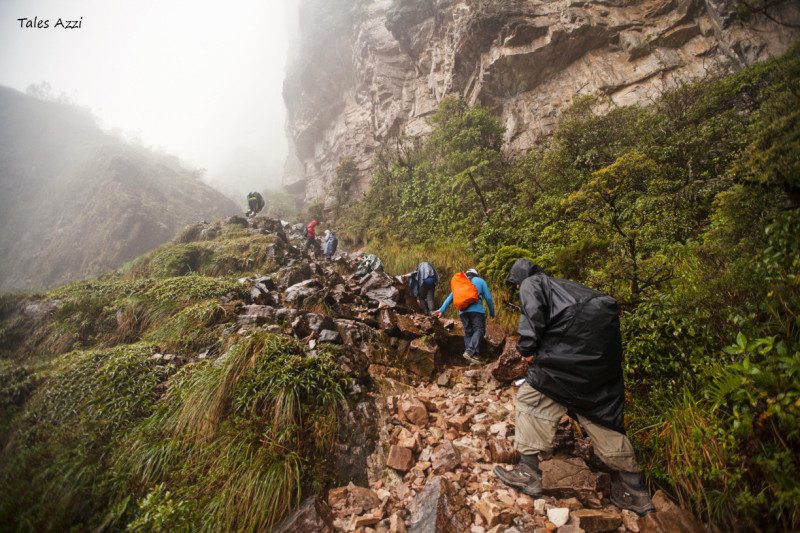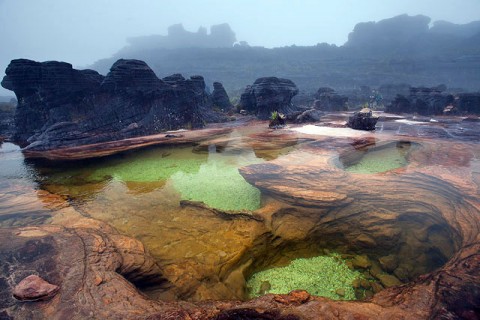

ANGEL FALLS
It is the world’s tallest uninterrupted waterfall, with a height of 979 metres (3,212 ft), and a plunge of 807 m (2,648 ft). The waterfall drops over the edge of the Auyán-tepui mountain in the Canaima National Park, a UNESCO World Heritage Site in the Gran Sabana region of Bolívar State. The height figure, 979 m (3,212 ft), mostly consists of the main plunge but also includes about 400 metres (1,300 ft) of sloped cascade and rapids below the drop and a 30-metre-high (100 ft) plunge downstream of the talus rapids.
The falls are along a fork of the Río Kerepacupai Merú which flows into the Churún River, a tributary of the Carrao River, itself a tributary of the Orinoco River.
A tepui is a tabletop mountain or mesa found in South America, especially in Venezuela and western Guyana. The word tepui means “house of the gods” in the native tongue of the Pemon, the indigenous people who inhabit the Gran Sabana.
Tepuis tend to be found as isolated entities rather than in connected ranges, each with a unique array of endemic plant and animal species.
Notable tepuis include Auyantepui, Autana, Neblina, and Mount Roraima. They are typically composed of sheer blocks of Precambrian quartz arenite sandstone that rise abruptly from the jungle. Auyantepui is the source of Angel Falls, the world’s tallest waterfall.
These table-top mountains are the remains of a large sandstone plateau that once covered the granite basement complex between the north border of the Amazon Basin and the Orinoco, between the Atlantic coast and the Rio Negro. This area is part of the remnants of the supercontinent Gondwana. The plateau began to erode and fragment about 300 million years ago, and about 70 million years ago the tepuis were formed from the remaining monadnocks.
There are 115 such mesas in the Gran Sabana in the southeast of Venezuela on the border with Guyana and Brazil, where the highest concentration of tepuis is found. The mountains tower over the surrounding area by up to 1,000 metres (3,000 ft).
Tepuis range in elevation from 1,000–3,000 metres (3,000–10,000 ft). The total surface area of all 115 tepuis is approximately 5,000 km2 (2,000 sq mi).
Because of their great age, some tepuis exhibit surface features and caves typical of karst topography, formed in more water-soluble rocks such as limestone. Caves here include the 671-metre-deep (2,201 ft) Abismo Guy Collet, the deepest quartzite cave in the world. Some mesas are pocked with giant sinkholes up to 300 meters (1,000 ft) in diameter and with sheer walls up to 300 meters (1,000 ft) deep. These sinkholes are formed when the roofs of tunnels carved by underground rivers collapse.



After a day off in Santa Elena (pop 18,500), we drove 2 hours NE via San Francisco to Paraitepui to start the 6-day trek up Roraima, the only tepui easily climbed.
Day 1 & 2. We had a great group of strong walkers. Hiking for about 3 ½ to 4 hours per day for 2 days we arrived at the base camp under the huge 600 m sandstone cliff. Now the rainy season, it rains often every day and the cheap umbrella I bought in Santa Elena was a godsend.
Day 3. We climbed about 900 m up the steep trail, walking through 2 waterfalls, to reach the top of the tepui. It is a surreal moonscape with all the normally pink to yellow sandstone and a deep black from a coating of cyanobacteria. Rudimentary walking routes wear off the black coating exposing the pink of the ancient heavily eroded sandstone. It is an amazing landscape with few distinctive landmarks. It is very easy to get lost and the guides were indispensable. There are buttes, creeks, marshes, small lakes, pink ‘beaches’ and low plants (some endemic to the top of Roraima and some carnivorous). Beds of crystals are everywhere but packs are checked on the way out to make sure none are taken.
The only animals besides a few birds are tiny black frogs with an orange belly (very similar to ones in Africa and it is presumed they are related and date back 150 million years to Gondwana when all the continents were joined). The weather changes fast and one sees clouds, mist, heavy rain, wind, cold, and bright sunshine all in the space of an hour.
We camped for 2 nights in one of the ‘hotels’, areas under big overhangs that offer protection from the frequent rain.
Day 4. On the first day, we hiked to the eastern area of the top to have spectacular, though brief views for hundreds of miles into the jungle of western Guyana. We saw the tourist sites of the Window (a huge sandstone boulder tipped giving views straight down the cliff), the Jacuzzi (pretty pools lined with quartz crystals where many swim) and sitting on the edge of the 600 m vertiginous cliff. With the whole second day on top, trips normally go 9 km out to Triple Point, the spot where Guyana, Brazil and Venezuela meet. On the way are Crystal Valley and the Pit, a large sinkhole. The guides are not keen to do it if the weather is not good and we are in the cloud and rain.
Day 5. Instead, we went to a great sandstone cave with a running stream. Down several hundred metres, with all the headlights off and the rushing water, it was a very meditative experience in the pitch black. Day 5 was the steep descent of about 6000 vertical feet down the cliff, past base camp to our campsite on the first night.
Day 6. It was a long 3 ½ hour trek in the rain through a hilly country with many creek crossings. The clay-based soil was slick and most everybody fell once. A few pounds of clay weighed down each shoe. This trail was best described as sticks like glue, slides like snot.

Mount Roraima
After 2 days in Santa Elena to allow my quads to recover from the big descent, I caught a night bus back to Puerto Ordaz, a 10 AM flight to Caracas and then the afternoon flight to Miami for an overnight. Then Dallas and Vancouver.



